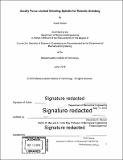Axially force limited grinding spindle for robotic grinding
Author(s)
Brown, Austin (Austin R.)
DownloadFull printable version (8.333Mb)
Other Contributors
Massachusetts Institute of Technology. Department of Mechanical Engineering.
Advisor
Alexander H. Slocum.
Terms of use
Metadata
Show full item recordAbstract
Grinding and Polishing of small parts is often easily performed by human hands, yet is challenging to automate. The grinding and polishing process is best done using a force-control scheme, which human hands perform naturally. Heavy robotic arms, which favor a position-control scheme, are difficult to control precisely, and trajectory errors can cause excessive grinding force which leads to burning of the part or destruction of the grinding wheel. Prior art of direct force control on a large robot arm requires the end-effector to have a 6-axis dynamometer, which is unwieldy, costly, and greatly limits the speed/precision of the process. We will discuss a new type of grinding spindle which is axially compliant, allowing the position-control robot arm to be used in a force-control nature. The spindle has a disjoint force-displacement curve, effectively operating in two modes: position-control mode at first, until a critical force is exceeded, when the spindle transitions into force-mode, keeping constant grinding force on the part though a certain range of travel. This limits the amount of force which can be imparted during grinding to a safe amount. The spindle is very simple and mechanically robust. We have built this hybrid position-force control spindle and tested it. The spindle was shown to perform correctly and successfully completed the test grind.
Description
Thesis: S.B., Massachusetts Institute of Technology, Department of Mechanical Engineering, 2018. Cataloged from PDF version of thesis. Includes bibliographical references (page 35).
Date issued
2018Department
Massachusetts Institute of Technology. Department of Mechanical EngineeringPublisher
Massachusetts Institute of Technology
Keywords
Mechanical Engineering.